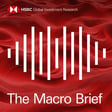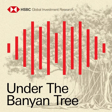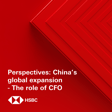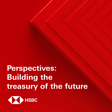Become a Creator today!Start creating today - Share your story with the world!
Start for free
00:00:00
00:00:01

Treasury Beyond Borders - Risk management during uncertain times: Treasury Insights from North America
As market shifts and supply chain strains, how are North American Corporates redefining risks as a source of strength?
Hear Melissa A Hotzoglou, Head of Corporate Sales US, Markets & Securities Services and Marissa Adams, Regional Head of Europe & Americas, Global Trade Solutions on how North American corporates are reassessing their FX and broader risk management strategies. Our panel explore some practical insights to help treasurers enhance resilience, protect value, and align risk frameworks with shifting global realities.
Transcript
Introduction to HSBC Global Viewpoint and TMI Podcast Series
00:00:01
Speaker
Welcome to HSBC Global Viewpoint, the podcast series that brings together business leaders and industry experts to explore the latest global insights, trends, and opportunities.
00:00:13
Speaker
Make sure you're subscribed to stay up to date with new episodes. Thanks for listening, and now onto today's show.
00:00:22
Speaker
Welcome to this special TMI podcast series in collaboration with HSBC called Treasury Beyond Borders, Balancing Risk and Opportunity Through Global Growth. I'm Eleanor Hill, Editorial Consultant at TMI, and over the course of this series of podcasts, I'll be exploring how global treasury is evolving amid geopolitical shifts and digital transformation.
00:00:44
Speaker
Across the episodes and with insights from HSBC experts, we'll dive into key themes both globally and across different regions, from managing risk in uncertain markets to leveraging new trade corridors and emerging technologies.
Risk Management During Uncertain Times
00:00:57
Speaker
For this episode, Risk Management During Uncertain Times, Treasury Insights from North America. I'm delighted to be joined by Melissa Putzoglu, who is Head of Corporate Sales US, Markets and Security Services at HSBC, and Marissa Adams, Regional Head of Europe and America's Global Trade Solutions, also HSBC.
00:01:17
Speaker
So ladies, welcome. It's really wonderful to have you here with us. And we've got so, so much to talk about. It's an environment that I don't even really know how to describe right now We've got heightened trade uncertainty. We've got shifting geopolitical alliances.
00:01:34
Speaker
So within this landscape, how are you seeing North American corporates reassessing their effects and their broader risk management strategies? Melissa, maybe you can give us a sense of what you're seeing. Is it a return to those kind of foundational principles, that sort of back to basics that we talk about a lot?
00:01:51
Speaker
Or are you actually seeing people thinking about new approaches? What's going on Tell us your thoughts. Hi, Eleanor. Great to be with you today. Absolutely. North American corporates and more generally, corporates globally are actively reassessing their FX and broader risk management strategies right now.
00:02:08
Speaker
This is largely due to the fact that trade uncertainty and macro volatility is really, really high. This is also evident in our recent HSBC trade poll survey, which targeted corporates across 13 global markets, and we had approximately 5,800 responses.
Adopting Technology in Risk Management
00:02:27
Speaker
Interestingly, from these responses, about 90% said that they were either planning or already updating their risk management strategies in response to the trade uncertainty and disruption that we're experiencing.
00:02:40
Speaker
What we're seeing is and overall return to fundamentals like managing cash flow at risk and utilizing layered hedging and an evolution in how these fundamentals are being applied.
00:02:52
Speaker
This is largely due to the fact that now we have better access to data and technology. Treasury teams right now are moving beyond just managing transactional risk, and they're spending a lot more time evaluating strategic programs that are tied to protecting firm value and shareholder value.
00:03:11
Speaker
We're seeing a greater strategic alignment across finance functions through the greater use of scenario analysis, stress testing of forecasts, and closer coordination within FP&A and the C-suite.
00:03:24
Speaker
This is really important when it comes to companies where FX can impact their guidance or their margin targets. When it comes to industry and sector, we are seeing certain nuances.
00:03:36
Speaker
For example, in industrial and manufacturing firms who typically have larger global supply chains, during this time, many of them are focusing on protecting their input costs and ensuring price stability.
00:03:49
Speaker
We're also seeing them use layered hedging programs, and now they're aligning the execution of those hedges with their procurement cycles. On the other hand, tech and pharma companies, which are typically exposed to more longer-dated earnings in multiple currencies, they're diversifying their forward hedging programs and incorporating options to protect against extreme tail risk.
00:04:11
Speaker
What's interesting to note is that despite the size of the company and the sector that they operate in, we're seeing an overall increase in the interest and the desire for education around FX options.
00:04:24
Speaker
This is really evident in companies that have multi-currency revenue streams or those that are exposed to asymmetric risk. Corporates are using options on top of their existing forward hedges to create collars that help them preserve upside potential or to hedge against event-driven risks like tariffs or the geopolitical shocks.
00:04:47
Speaker
There's also this now growing adoption of advanced analytics.
Young Treasurers and Market Uncertainty
00:04:52
Speaker
AI and third-party platforms are really coming together to help treasurers gain real-time insight and more agility in how they make risk decisions.
00:05:01
Speaker
So it's really not this binary choice between going back to basics or adopting something radically new. It really is a combination of the both. Companies have to solidify their core principles, and they're also leaning in to incorporate new tools that really help them to manage this really complex environment that we're operating in.
00:05:22
Speaker
Yeah, Melissa, I think that hits the nail on the head. I know the treasurers that I'm speaking to, they're doing both of those things in tandem. They've got awful lot on their plate at the moment. So echo what you said around the options as well. I don't think I've had as many requests for information on using options as I have in the last month or so. So it's a really interesting time, particularly for some younger treasurers who maybe haven't lived through or worked through a period of market uncertainty like we're going through now. So there's an awful lot going on, but there's good opportunities for people as
Supply Chain Resiliency Post-COVID
00:05:53
Speaker
well. But Marisa, let's bring you in here and get an idea from the supply chain side of things.
00:05:58
Speaker
With everything that we've described there, how are you seeing companies adopting things like their operational strategies? Supply chain realignment is something that we hear about a lot and they need to stay resilient in the face of all of these trade disruptions, all of these risks. So tell us a little bit about what you're seeing, maybe some examples or emerging trends from clients that you've worked with.
00:06:21
Speaker
Yeah, absolutely, Eleanor. And I've had the privilege over the past few months to have spent a great amount of time on both sides of the Atlantic with North American corporates here in North America, as well as in Europe with our European clients, as well as North American clients working in Europe. So it's been a really interesting time with treasury teams, as well as supply chain teams. We've actually started to speak a lot more to both procurement and treasury. And I think this is a really interesting dynamic where even within our corporates, often they don't speak to each other.
00:06:49
Speaker
One of the things I'd say is that what we're seeing is that, one, they're having to work a bit more together. But two, this concept of supply chain resiliency, which I have to say I've been banging on about for years, has now suddenly become more of a forefront and more of a topic of discussion, both from a Treasury perspective as well as from procurement teams and all the way up to the C-suite. I'd like to say now that after post the COVID pandemic,
00:07:12
Speaker
so p supply chain resiliency became a C-suite topic and it hasn't ceased to be there. yeah Having said that, a number of the shifts that we saw through COVID but around, let's say, supply chain disruption, not being able to get goods into the country, looking at backup ideas have become actually more important now.
00:07:30
Speaker
in the current geopolitical and economic backdrop for really three reasons. One, there aren't really any safe havens. So even if you're looking at the current environment, but how you bring production perhaps closer to the source of sale or diversifying it from your current suppliers, your traditional suppliers, it's actually quite challenging to find one good solution. So treasury teams and procurement teams are having to be really creative, but also trading off between how expensive it is to bring production or resiliency versus the input costs and actually sales to their clients. And clearly in the current environment where costs are rising from a tariff perspective, this is an ever more important discussion that they're having to have.
00:08:12
Speaker
The second thing I'd say is that as much as treasurers look at the full end-to-end working capital cycle, it's now a chance, and I've seen a lot more that are really interested in the end-to-end payment terms. So how do we look at days of DPOs, days of payables outstanding, days of sales outstanding, days of inventory outstanding.
00:08:30
Speaker
And interestingly, one of the things that we do for clients is we, particularly those clients that are publicly traded based on public information, is we provide peer comparison. And it's always really interesting where it's not that they don't know it, but when you really see on the side, it's, wait a minute, I'm actually paying my suppliers a lot earlier than my competitors.
Optimizing Working Capital and Sourcing Strategies
00:08:48
Speaker
I'm collecting my sales a lot later.
00:08:50
Speaker
And one of the things that we're seeing too is it doesn't take a significant monumental shift to make a big difference to the bottom line. And it's one of the things in the toolkit where we say around inventory ownership, supply chains, receivables or invoice financing that actually I've seen treasurers move a lot closer to that now and a lot more focus and investment because they've done all the basics. And again, I think to Melissa's point, they're redoing the basics, but now we're looking for additional tools to really optimize both that supply chain resiliency, yeah but ultimately corporate profits. Yeah, which other levers can we pull? and But like you say, that benchmarking among peers always makes it kind of ah very much come up the agenda. I think it really brings it home, doesn't it?
00:09:31
Speaker
Totally. And final thing I'd say is around the supply chain resiliency piece, we've been doing a lot of work with corporates around risk management, and how they look at their supply chain resiliency and the risks around it.
00:09:43
Speaker
And I think we have three steps that we recommend. So one is that clients take a risk-based approach to their sourcing analysis. So they're not looking at specific SKUs or elements, but where do they see the biggest risk geopolitically, economically, labor-wise? There's all kinds of challenges in the labor market.
00:09:58
Speaker
Two, analyzing the consequences of that supply disruption. So what would that mean? Doesn't mean they should invest elsewhere. And thirdly, redoing this on a regular basis. And I think it's become ever more important in the current environment that we were maybe saying six to 12 months a year ago. Now, probably every couple months, you've got to redo that analysis to really keep current and keep abreast with your competitors. so Yeah, absolutely. It's just all moving so quickly. And Melissa, let's bring you back in because obviously with these changing supply chain relationships and dynamics, there's potentially new currencies coming in. People are having to think about hedging in different currencies and then think about different instruments as we've spoken about earlier. They're thinking about options and other things.
00:10:39
Speaker
But when I speak to it a lot of corporates who aren't particularly familiar with hedging, haven't done a lot of it before, they think that maybe it's a little bit expensive or it's a little bit complex and they're not sure how to approach it.
FX Hedging: Misconceptions and Automation
00:10:52
Speaker
So I know you do this day in, day out. You work with clients on all kinds of different hedging programs. So maybe just help demystify that a little bit for us. what are some of the common misconceptions and what would you say that good risk management hygiene looks like right now?
00:11:07
Speaker
There is a really common perception, and it's often probably one of the biggest hurdles that we see to proactive risk management. And it is that perception that FX hedging is either too expensive or too complex.
00:11:20
Speaker
Many companies still think that hedging in an environment where volatility very high is probably not the most optimal time. And it often becomes the hardest time if you've never implemented a program to implement a program.
00:11:33
Speaker
The cost of hedging actually is really relative. And I think that's how we need to be thinking about it. yeah Because in many cases, not hedging can be far more costly when currency moves impact your margins or earnings without any warning.
00:11:47
Speaker
One of the key misconceptions that we also tend to see is that you have to hedge all of your exposures or that it's this all or nothing decision. The reality is that effective risk management is really all about prioritization and policy.
00:12:01
Speaker
It really does start with knowing your exposures, understanding how FX volatility impacts your cash flows and earnings, and putting a structured program in place, even if that's just covering the most material of all your risks.
00:12:15
Speaker
And this is really where we're seeing technology and automation changing the game for corporates of all sizes. We have a solution here at HSBC. It's called AutoHedge, which is really helping to remove some of this complexity by fully automating the execution of hedges based on pre-agreed rules that align with companies' forecasts, their hedge policies, and their overall risk tolerance.
00:12:38
Speaker
This product is really ideal for businesses that have reoccurring exposures. So think of something like monthly sales or supplier payments. And these companies want consistency in how the exposure is hedged and managed without having to manually trade every single time.
00:12:52
Speaker
Yeah. This eliminates a lot of that operational burden, which can sometimes be a bit scary for companies, especially those that have smaller treasury teams. By taking away this operational burden, it really helps them to lean in and stay focused on those high-value risk analyses that all companies need to be doing in this environment.
00:13:10
Speaker
So good risk management hygiene in 2025 is about three things. Clarity. consistency, and control. It means having a clear hedging policy with defined objectives.
00:13:23
Speaker
It means leveraging automation to reduce manual effort and the execution risk. And as Marissa mentioned just two minutes before, regularly reviewing your business and reviewing your exposures, your hedge instruments, and your business assumptions so that your hedges reflect the business environment that you're operating in.
00:13:42
Speaker
That makes complete sense. And like you say, it doesn't have to be everything. It's not all or nothing that you're hedging. You can just target particular things. You can be intentional about it. And there are tools available to help you. And it's not nearly as complicated as the perception suggests.
00:13:58
Speaker
So hopefully our listeners will get a sense of what's available and what's going to be helpful for them today.
Impact of Cross-Border Operations on Liquidity
00:14:04
Speaker
So Melissa, thank you for that. But Marissa, i just wanted to come back to you on the supply chain side of things, because we've spoken about these realignments and Melissa's given us a great overview of what's happening from the FX side and what corporates might need to be thinking about. But...
00:14:17
Speaker
From the supply chain side, we've got these cross-border treasury operations that are going through changes. What does that mean for working capital? What does it mean for liquidity management? What should our listeners be thinking about?
00:14:30
Speaker
And Eleanor, it's a great question. And I think that at the moment, it has become ever more imperative that working capital, not that it hasn't ever been at the forefront of a treasurer's mind, but really, even for those companies that have tons of cash, work optimizing working capital is the key towards them being successful or not in the future. And I'd say we've seen a lot of corporates who, given the current disruption, have looked at revising their earnings forecasts. Some of them actually removing any forward guidance as a result of that. So one of the things that I would say is that regardless of how much international trade a corporate has, the current environment is meaning that every single treasurer should be looking at how do they optimize their working capital and key creative solutions.
00:15:11
Speaker
Three things that I'd say. So firstly, there is ah quite a short-term working capital cap when it comes to tariffs. So tariffs are paid at the point of entry by the importer, and you might not actually recoup those tariffs for another 60 90 days.
00:15:24
Speaker
That might seem like a small amount, but if you multiply that by multiple countries, by multiple rates, it adds up. So that's one of the things that we've looked at. And we actually launched a product, TradePay, which is a product that we already had in existence, which effectively is a really simple digital way for corporates to pay their suppliers. But we've actually launched that as well for the payment of import duties.
00:15:44
Speaker
which was really exciting. So what we can do directly for a corporate is say, okay, you have to pay x amount of duties. We'll pay U.S. Customs and Border Protection or your your customs broker and then finance that period. So it really creates an exciting opportunity for them to do it simply.
00:15:59
Speaker
Secondly, I think complexity around international trade and working capital has become a lot more significant. So any place where they can be more simple, as we know, I think Melissa mentioned as well, and so you, Eleanor, some treasury teams are younger,
00:16:10
Speaker
Some are smaller and none of these changes are without effort and work. So the more that there's simple solutions where we can support them, certainly that's what our TradePay product does.
00:16:21
Speaker
The second thing I'd say is that the different financing options available, and we talked a little bit before around supply chain finance or inventory finance or inventory ownership are things that, again, corporates may have gone before, listen, I'm not quite sure that I see such a benefit to this. It might be a bit expensive to implement. But actually, in the current environment, particularly in supply chain resiliency, creating strong bonds with your suppliers is going to be one of the key elements of success. And we've already seen, I can give you a couple anecdotal examples, particularly in the garment industry, where
00:16:54
Speaker
One of our clients had a strong supplier relationship in Bangladesh. They'd continued for many years importing for them. Suddenly, that supplier has a lot more customers and can't actually prioritize their
Supplier Relationships and Financing Options
00:17:06
Speaker
orders.
00:17:06
Speaker
Now, if they'd had a supply chain finance program in place where that corporate was actually anchoring and providing that financing, that might have been a little bit different. And so I think there's a ah point about thinking about your supplier relationships, not just an How cheaply can I get it? How efficient is it? But what do I need to do to support them? And we continue to see persistently high rates in a number of the markets that we operate.
00:17:29
Speaker
And as a large North American corporate, you can go to your bank and get a larger of a facility. But actually, if you're a supplier in many of the other markets, you can't. So this becomes ever more important, both in an inflationary environment.
00:17:40
Speaker
But also an environment where with increased costs of tariffs, both customers and suppliers may have to take in more costing and actually look at that from a bottom line perspective.
00:17:51
Speaker
So that's certainly something that that we've seen. And those conversations, as I say, I've been in trade and working capital for most of my career. and What I'd say now is that every client wants to talk to us about this, not just those who thought maybe they were super international. And I think that's a message that I'd have for treasurers is that look at some of these other options, look at these tools that you may have heard of, you might not have been as familiar on.
00:18:12
Speaker
They may have felt a little complex, but we've made such strides also in the industry and particularly very proud of what HSBC has done on the digital front, where we've made all these a lot simpler for our clients to implement. And it can really help them both from a profitability perspective. We know that corporates that optimize their working capital tend to have a higher valuation.
00:18:31
Speaker
So this isn't just about the nitty gritty of trade and supply chain, but it really is a strategic imperative, both from a C-suite perspective, but also from a treasury perspective as well. Yeah, absolutely. On that strategic front, and I love what you said about it's not only supporting the suppliers, but it's ah ring fencing that support in your supply chain as well and making sure that you're going to be a priority and Some interesting things for everyone to think about there and the kind of different w risks that are out there and the different ways that they approach them. Melissa,
Managing FX and Liquidity Risks with Technology
00:18:58
Speaker
talking about risks, everyone out there, all of the treasurers are thinking, okay, i need to do some more scenario modeling. I've got to get my contingency planning up to date.
00:19:07
Speaker
But some of them are not knowing even what kind of operational risks to think about because it's just such an unusual environment right now. They're maybe thinking about... potential disruptions, even to payment rails or cross-border flows. So tell us a little bit about what you are seeing from leading treasury teams, what they're doing, how they're preparing.
00:19:27
Speaker
Sure. Treasurers really do need to think about risk beyond just the traditional market risks. And operational risk can be quite disruptive. It can cause clients to have issues with liquidity, as Marissa mentioned, working capital and even payroll.
00:19:43
Speaker
And right now, the conversation is how do we manage through that? That's front and center for all treasurers, again, both of large and smaller companies. For global treasury teams, having financial infrastructure resilience is really top of mind.
00:19:57
Speaker
And that entails taking look at their systems, their platforms, their partners, and everything that supports their day-to-day operations and figuring out whether or not those partners and those processes can really hold up under periods of stress.
00:20:12
Speaker
Leading treasury teams that we're seeing right now are being very proactive in reviewing their banking relationships. They're taking extra steps to set up regional liquidity hubs, and they're ensuring that they have contingent payment opportunities and rails and capabilities.
00:20:27
Speaker
They're also really taking a look at where cash is being held globally. How accessible is that cash? And what are the fallback options if, for example, a key platform or partner becomes challenged?
00:20:39
Speaker
And then here's where it all links back to FX. When treasurers engage in these types of exercises and when they reassess where cash is held and how mobile that cash is, they're also thinking about the currency risk that comes with that.
00:20:52
Speaker
yeah Cash that's trapped in the wrong currency or in the wrong place at the wrong time can create a dual challenge to many treasurers.
00:21:03
Speaker
It basically becomes, Eleanor, ah liquidity issue and an FX issue, an exposure. So these theoreticals of what happens under periods of high stress, they're not theoreticals anymore.
00:21:16
Speaker
They're real-world practical scenarios that treasury teams are really engaging and testing to ensure that they have resiliency across their treasury teams. I think it's really important to remember that the goal isn't to eliminate operational risk.
00:21:31
Speaker
Unfortunately, that's impossible. yeah But leading treasury teams right now are really building the capacity and the strength to operate through these potential disruptions. Yeah, just putting yourself in the best place to get through it and keep everything flowing. And one part of that will be getting the right systems in place, the right backups in place. We've spoken a little bit about what happens if you get disconnected from a key system. But at the same time, Treasury teams have so many other things going on. So if we think about...
00:22:02
Speaker
and Recently, in the last couple of years, there's been this huge push for digital transformation. ah In previous crises that we've seen, that I've written about during my career, we've seen technology maybe taking a bit of a backseat because everyone has just so many other things to think about.
00:22:20
Speaker
It'd be interesting to hear thoughts from both of you on whether you're still seeing technology being invested in, playing a central role, helping treasurers in the Americas manage w risk more effectively, or are they just focused on this kind of firefighting mode at the moment? I don't know.
00:22:35
Speaker
Melissa, maybe you kick us off and then Marissa can give us her thoughts. Sure. You're absolutely right, Eleanor. During times of crisis or market stress, digital transformation unfortunately does find its way or gets pushed down the priority list. But what's really interesting right now is that among treasurers here in the Americas, there's a big change and or a major shift in the mindset when it comes to digital technology and automation.
00:23:02
Speaker
What we're seeing is that technology is no longer this nice to have. It's actually become mission critical. Treasurers are as operating in fast-moving, highly complex environments, and they need these tools to help them see risk clearly and also act very quickly and decisively.
00:23:19
Speaker
So we're seeing tech play a critical role in three big areas. First, it's visibility. Treasurers need real-time insight into where their cash is, what their exposures look like, and how they're changing, especially when they're operating in multiple markets and have various entities.
00:23:37
Speaker
This is driving the adoption of integrated treasury platforms, real-time dashboards that are giving a single consolidated view. The second is speed and control.
00:23:48
Speaker
Whether it's hedging their FX risk, reallocating cash, or running scenarios in a crisis, the ability to act quickly with confidence is a competitive advantage and no treasurer wants to be without this.
00:24:02
Speaker
Technologies that enhance automation, straight through processing and APIs are really changing the game and enabling this responsiveness while also reducing operational risk along the way.
00:24:13
Speaker
And the last, is insight. AI, machine learning, and predictive analytics, they're all starting to make a real difference here for treasurers. They're helping the treasury teams forecast more efficiently,
00:24:26
Speaker
It's forcing them to stress test their assumptions. And it's even flagging emerging risks that might not have been spotted otherwise. So unfortunately, while budgets, they do come under pressure and they're not unlimited, the mindset has definitely shifted.
00:24:41
Speaker
And we're not seeing leading treasuring teams pausing at any point in time. Instead, they're really taking the steps to prioritize the tools that are making them faster, smarter, and more resilient.
The Slow Digital Advancement in Trade Industry
00:24:53
Speaker
Yeah, it's actually acting as a catalyst for change, which is what I'm seeing for sure, which is great. And I think, Marissa, we're seeing that in the supply chain and trade side of things as well. I know there's been tons going on around digital evolution in the global trade industry recently, but tell us what you're hearing from the corporates that you're speaking to.
00:25:11
Speaker
Absolutely. And I'd agree with Melissa that I actually see Treasury teams doubling down on their tech investment. And that doesn't mean, again, that there's not constrained budgets, as Melissa mentioned, but they're not deprioritizing it. And I think for three reasons. The first thing is that just like all of us, Treasury teams continue to be stretched. And whether that's ah in a fight for talent or, again, Treasury teams themselves having to manage their cost efficiency, the only way that they can get better is through these technological tools, whether that's reducing paper-based processes, the use of ai and analytics, that visibility, having a an FRP or an ERP platform that really works for them in ah the best beneficial way. So I'm not seeing any of that slowing down.
00:25:52
Speaker
In trade in particular, we're an industry that we we like to say, are we going to be the last analog frontier? Not in a proud way, but that's just something that certainly comes out. And it is still very paper-based. And actually, in the current economic and geopolitical situation, I almost think there's going to be a little bit of a step backwards where paper becomes a bit more important. One, because so many corporates haven't had to utilize a number of these tools, particularly in international trade, because they've worked in free trade zones previously.
00:26:21
Speaker
yeah So there isn't an automatic solution for that. We've seen also, if we look across the trade space, a number of fantastic fintechs that have come forward with specific technological solutions for the challenges that we've had from a paper-based industry.
00:26:34
Speaker
But a lot of them haven't succeeded. And I think that part of that, if you look at trade, is that it is so intertwined and internationally connected with governments, with international organizations, with multilateral institutions that You can get a change on one side of a country, but you can't get it elsewhere. Now, the UK, as an example, put in a Digital Trade Act that will start to change things. But if the other countries don't accept that, we don't actually end up seeing that technological benefit coming through.
00:27:01
Speaker
Having said that, AI is being utilized in all kinds of exciting ways. We use it in some of our document checking where it would have been and manual previously. There are some different standards coming into place.
00:27:12
Speaker
So we see movement towards it. It's just going to take a little bit more collaboration to get done. Having said that, I think that in every conversation that I have with Treasury teams, they want to know what we're doing. And HSBC as a whole, we invested a significant amount of money upgrading our own trade platform. So HSBC Trade Solutions, it's best in class in the industry.
00:27:31
Speaker
And that's also helpful for our clients because if we can be faster in how they trade, even if they can't be faster on their end and digitize that process more, that's one step. And also inspiring and showing them what the art of the possible is when we're processing trade and working capital transactions.
00:27:46
Speaker
ah whole Brilliant stuff. theres There is an awful lot going on. And I know what you mean about that. This kind of might step back a little bit from all of the digital progress, in terms of pockets. But I did speak to one bank.
00:27:59
Speaker
It was about three months or so ago, and it was a local bank in a particular geography. And that they were just saying, no, we're really happy with the way paper works. So we're not interested in digital. digitizing, which was quite surprising to me, although I shouldn't have been surprised, but I know what you mean. But I think that the overall mission is there and we've got some good innovations coming out from the likes of HSBC and there's a lot of corporates interested in making the world a better place in terms of going digital as well. Let's see, let's see.
00:28:25
Speaker
And Eleanor, I would just add to that, HSBC is 100% committed to digitization. And the more digitization we have, the more trust we can create between our customers, the better that we can actually manage those risks, whether those are cyber risks, whether they are fraud risks, etc. So yeah for us, it's it's not only the efficiency angle, but it's ah an element that this will make trade safer and better and more accessible to companies of all sizes.
00:28:48
Speaker
Yeah, absolutely.
Proactive Risk Management and Future Alignment
00:28:49
Speaker
It is a no brainer. OK, great stuff. Ladies, we've covered an awful lot in this podcast so far. There's been some really good insights along the way. So I'm just wondering if we can wrap up maybe with each of you giving us sort of three recommendations to our treasurers out there across the Americas.
00:29:07
Speaker
How can they navigate everything that's going on this volatility? How can they prepare for what's next? So what would your recommendations be? I know it's really mean to limit you to three, but Melissa, if I put you in the hot seat, what would you say?
00:29:21
Speaker
Sure. Eleanor, it's been a pleasure to be here with you. And again, thank you for making the time and space for this really important conversation. And I would say that to all the treasurers, all those that are in the Treasury teams, we appreciate and acknowledge that this environment is one that is constantly changing, constant changing.
00:29:37
Speaker
the evolving. And we appreciate that sometimes decisions need to be made quite quickly. Sometimes having the most information at your fingertips to help you in deciding what to do is super important. And we do hope that our clients and and the listeners continue to leverage HSBC as a key go-to partner. Three recommendations, definitely not easy, but I'll do my best to try to narrow it down.
00:30:00
Speaker
So the first I would say is to shift from reactive to proactive risk management. Don't wait for volatility to hit your earnings or cash flows before you start to take action or make plans.
00:30:15
Speaker
It's really important, given the volatility that we're seeing, for companies and treasurers to really revisit their hedge objectives. Everyone should be challenging their assumptions, and they should be running updated stress tests.
00:30:27
Speaker
The goal right now is to try to stay ahead of the curve as much as possible, to be prepared, and to just have a plan in place. The second would be to build optionality into your hedging strategy.
00:30:40
Speaker
In this environment, it's really important to remember that flexibility is just as critical as protection. FX options can help manage asymmetric risks. They can help deal with uncertain forecasts, and they can help protect against extreme moves, which we've seen since the start of this year.
00:30:58
Speaker
And this can all be done without locking into rates that might turn out to be unfavorable. And then the last one would be to align your FX risk management with global trade dynamics.
00:31:10
Speaker
As Marissa shared with us earlier, supply chains are shifting. Trade flows are evolving. And that's changing the currency map for many companies. So treasuries need to be in close sync with their procurement and commercial teams to really make sure that FX risk is managed in tandem with sourcing,
00:31:29
Speaker
decisions and trade strategy at the beginning and not as a catch up. So in this environment, Eleanor, I would say effective treasury leadership means aligning market risk management with the firm's broader business objectives so that risk is managed not just efficiently, but also decisively.
00:31:49
Speaker
Yeah, but I love that you emphasised those relationship elements as well, Melissa. like It is about speaking to your colleagues in other departments and it's bringing out those soft skills. And also, like you said, speaking to HSBC, speak to your banks because there's people that can help you with these things. And quite often people are suffering in silence or thinking, oh, I don't know what to do. Yeah.
00:32:09
Speaker
Just lean on the human side of things as as well as the technology would be my little suggestion for everyone off the back of what you said there, Melissa. But Marissa, what would you add? What would you say your top three takeaways?
00:32:22
Speaker
So my top three in no particular order are number one, get to know your supply chain. So we've still seen even after the COVID pandemic and now in disruption, less than 50 percent of corporates know who's in there first and then second tier suppliers. So if you don't know what's out there, you don't know where risks are there. So invest the time in figuring out where and who is in your supply chain and then figuring out those risks.
00:32:45
Speaker
Secondly, I've said it a few times, but working capital has to be optimized. And there's a bit, there's a point where you can't optimize it too much because then you've gone on to be at the further end where you're not getting those benefits. But look at every day, how do you optimize your working capital?
00:32:58
Speaker
Where are the needs changing and how do you get to that tomorrow? And I think this is a really key bit when I get into my third point, which Melissa already touched on beautifully. And I talk about it as the triangle. So I've got treasury, procurement and sales teams.
00:33:11
Speaker
And if those three angles of the triangle aren't speaking together, you're not optimizing your working capital, you're not mitigating your risks, and you're not actually getting the benefits from the treasury KPIs, from how you can collaborate together to really benefit. So those are the top three recommendations that I would have, and I think they're in tandem with Melissa's as well. But really looking at that supply chain understanding the working capital and, as you said, collaborating with your colleagues in a real meaningful way because yeah sometimes you have the same objectives but you're working in silos.
00:33:40
Speaker
And I certainly say that the teams that I've seen who have managed to bring that triangle together have been the most successful in optimizing their working capital and really understanding where their supply chain is and ultimately feeling confident going into any risk scenario coming into the future. Yeah.
00:33:54
Speaker
That's
Conclusion and Thanks
00:33:55
Speaker
it. And working together with a shared goal, I think, always helps as well. Ladies, thank you so much for that. You've given us so much to think about and to take away and some wonderful recommendations to focus on at the end there. And it's been a pleasure having you here.
00:34:10
Speaker
So at once again, thanks for joining us, sharing your expertise. And that is a wrap now for this episode of Treasury Beyond Borders. Thank you also to our listeners for tuning in. And I hope you've enjoyed the discussion. So be sure to subscribe and stay updated on our upcoming episodes in this series.
00:34:27
Speaker
And also watch out for the articles that we've got accompanying them. But for now, thanks again to our wonderful speakers. And thank you to everyone for listening.
00:34:49
Speaker
Thank you for joining us at HSBC Global Viewpoint. We hope you enjoyed the discussion. Make sure you're subscribed to stay up to date with new episodes.












